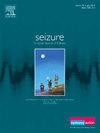Seizure detection using the wristband accelerometer, gyroscope, and surface electromyogram signals based on in-hospital and out-of-hospital dataset
IF 2.7
3区 医学
Q2 CLINICAL NEUROLOGY
引用次数: 0
Abstract
Objective
Wearable devices are effective for detecting generalized tonic-clonic seizures (GTCS). However, many daily activities are often misclassified as GTCS, leading to a decline in user confidence. This study recommends utilizing wristband three-axis accelerometer (ACC), three-axis gyroscope (GYRO), and surface electromyography (sEMG) signals for GTCS detection and presents a novel seizure detection algorithm that offers high sensitivity and a reduced false alarm rate (FAR).
Methods
Inpatients with epilepsy and out-of-hospital healthy subjects were recruited and required to wear a wristband device to collect wristband signals. The proposed algorithm comprises five steps: preprocessing, motion filtering, feature extraction, classification, and postprocessing. The variations in performance across different signal combinations were compared. Additionally, the impact of training the model using only inpatient data versus the complete dataset on the algorithm's performance was also investigated.
Results
Wristband signals were collected from 45 patients and 30 healthy subjects, encompassing a total of 3367.3 h and including 60 GTCS. The proposed algorithm achieved 100 % sensitivity and a FAR of 0.1070/24 h. It demonstrated higher sensitivity and lower FAR compared to combinations with fewer signal modalities. In addition, the model trained on only in-hospital data demonstrates high sensitivity (98.33 %) and high FAR (0.9845/24 h).
Significance
The algorithm proposed for detecting GTCS using wristband ACC, GYRO, and sEMG signals achieved encouraging results, demonstrating the feasibility of this signal combination. Furthermore, incorporating out-of-hospital data into model training proved to be an effective solution for reducing FAR, which could facilitate the clinical application of seizure detection algorithms.
使用腕带加速计、陀螺仪和基于院内和院外数据集的表面肌电图信号进行癫痫检测
目的研究可穿戴设备对全身性强直-阵挛性癫痫(GTCS)的检测效果。然而,许多日常活动经常被错误地归类为GTCS,导致用户信心下降。本研究建议使用腕带三轴加速度计(ACC)、三轴陀螺仪(GYRO)和表面肌电图(sEMG)信号进行GTCS检测,并提出了一种新的癫痫检测算法,该算法具有高灵敏度和低误报率(FAR)。方法招募癫痫患者和院外健康受试者,佩戴腕带装置采集腕带信号。该算法包括五个步骤:预处理、运动滤波、特征提取、分类和后处理。比较了不同信号组合的性能变化。此外,还研究了仅使用住院患者数据与完整数据集训练模型对算法性能的影响。结果共采集45例患者和30例健康受试者的腕带信号,共3367.3 h,其中60例为GTCS。该算法实现了100%的灵敏度和0.1070/24 h的FAR。与信号模态较少的组合相比,该算法具有更高的灵敏度和更低的FAR。此外,仅在医院数据上训练的模型具有较高的灵敏度(98.33%)和较高的FAR (0.9845/24 h)。意义本文提出的利用腕带ACC、GYRO和sEMG信号检测GTCS的算法取得了令人鼓舞的结果,证明了该信号组合的可行性。此外,将院外数据纳入模型训练被证明是降低FAR的有效解决方案,可以促进癫痫发作检测算法的临床应用。
本文章由计算机程序翻译,如有差异,请以英文原文为准。
求助全文
约1分钟内获得全文
求助全文
来源期刊

Seizure-European Journal of Epilepsy
医学-临床神经学
CiteScore
5.60
自引率
6.70%
发文量
231
审稿时长
34 days
期刊介绍:
Seizure - European Journal of Epilepsy is an international journal owned by Epilepsy Action (the largest member led epilepsy organisation in the UK). It provides a forum for papers on all topics related to epilepsy and seizure disorders.
 求助内容:
求助内容: 应助结果提醒方式:
应助结果提醒方式:


